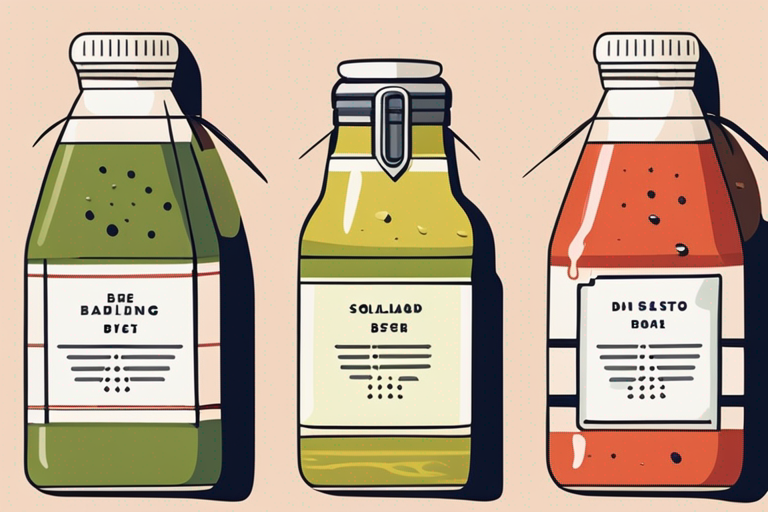
The Ultimate Guide to Salad Dressing Expiration Dates
Get Your Free Food Safety Cheat Sheet
30 most common foods with instant answers. Print it and stick it on your fridge—completely free!
The Ultimate Guide to Salad Dressing Expiration Dates
Are you a salad lover who enjoys adding a delicious dressing to your greens? If so, you may have wondered about the expiration date of your favorite salad dressings. In this comprehensive guide, we will delve into the world of salad dressing expiration dates, providing you with essential information to ensure your dressings are safe and flavorful.
Understanding Salad Dressing Expiration Dates
Salad dressings, whether homemade or store-bought, typically come with expiration dates printed on their packaging. These dates indicate the recommended timeframe for consuming the dressing to ensure optimal quality and safety. Here's what you need to know about salad dressing expiration dates:
Types of Salad Dressings
Different types of salad dressings have varying shelf lives due to their ingredients and preparation methods. Common types of salad dressings include:
- Oil-based dressings: These typically last longer due to the preservative properties of oil.
- Cream-based dressings: Creamy dressings, such as ranch or Caesar, have a shorter shelf life due to their dairy content.
- Vinegar-based dressings: Vinegar acts as a natural preservative, extending the shelf life of these dressings.
Factors Affecting Expiration Dates
Several factors can influence the expiration date of salad dressings, including:
- Storage conditions: Proper storage in a cool, dry place can extend the shelf life of dressings.
- Ingredients: Dressings containing perishable ingredients like dairy or fresh herbs have shorter expiration dates.
- Packaging: Airtight packaging can help preserve the freshness of dressings.
Decoding Expiration Dates
Understanding expiration dates on salad dressing labels is crucial for maintaining food safety. Here's how to decode these dates:
"Best By" Date
The "best by" date indicates the date until which the dressing is expected to retain its optimal flavor and quality. Consuming the dressing after this date may result in a decline in taste.
"Use By" Date
The "use by" date signifies the last date recommended for consuming the dressing for peak quality. Consuming the dressing after this date may pose health risks.
Storing Salad Dressings Properly
Proper storage is key to extending the shelf life of salad dressings and maintaining their quality. Follow these storage tips:
- Refrigerate: Store opened salad dressings in the refrigerator to prevent spoilage.
- Seal tightly: Ensure the dressing bottle is tightly sealed to prevent air exposure.
- Avoid temperature fluctuations: Fluctuating temperatures can impact the stability of dressings.
Signs of Spoiled Salad Dressings
To ensure food safety, be vigilant for signs of spoilage in salad dressings. Discard the dressing if you notice any of the following:
- Off odor
- Unusual texture
- Mold growth
- Separation of ingredients
Conclusion
In conclusion, understanding salad dressing expiration dates is essential for both quality and safety. By following proper storage practices, decoding expiration dates, and being aware of signs of spoilage, you can enjoy your favorite dressings with peace of mind. Remember, when in doubt, it's better to err on the side of caution and discard any dressing that appears spoiled. Stay informed, stay safe, and savor your salads to the fullest!

Authoritative Food Safety References
These agencies and university labs inform every tip and health precaution we publish.
USDA FoodKeeper – Cold Storage Guidelines
Official refrigerator, freezer, and pantry timelines maintained by the U.S. Department of Agriculture.
Visit USDA FoodKeeperFDA Produce Safety Rule & Grower Guidance
Field-to-fridge handling practices that prevent contamination of fruits, vegetables, and leafy greens.
Visit FDA Produce SafetyCDC Foodborne Illness Prevention Hub
Surveillance-backed guidance on pathogens, symptoms, and steps to reduce foodborne illness risk.
Visit CDC Food SafetyUC Davis Postharvest Technology Center
University research detailing optimal storage atmospheres for produce after harvest.
Visit UC Davis PostharvestPenn State Extension – Home Food Preservation & Safety
Peer-reviewed extension bulletins on safe canning, chilling, and reheating practices.
Visit Penn State ExtensionHow can I tell if my salad dressing has gone bad?
Can I use expired salad dressing?
How should I store salad dressing to prolong its shelf life?
Can I freeze salad dressing?
Get Your Free Food Safety Cheat Sheet
30 most common foods with instant answers. Print it and stick it on your fridge—completely free! Want more? Upgrade to the complete guide with 70+ foods.
Scan your food directly and get instant safety info using our AI-powered camera feature.